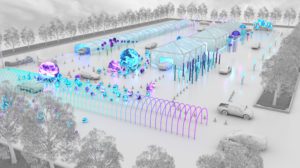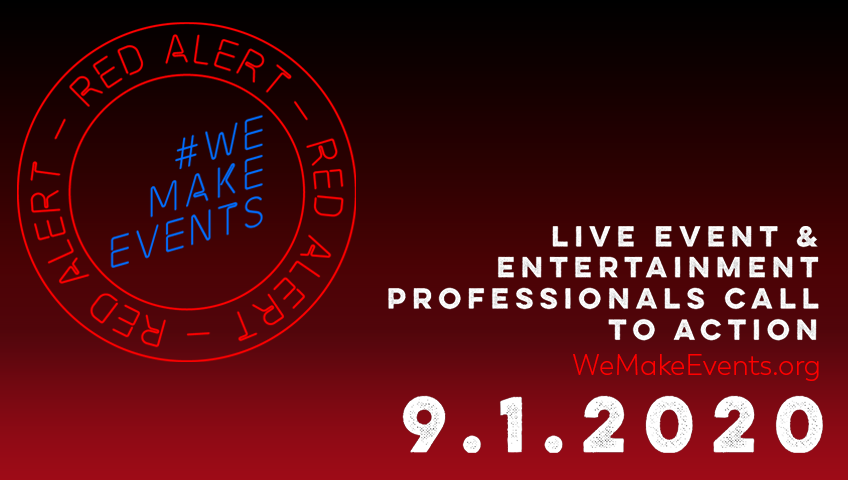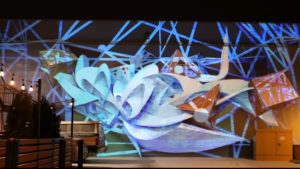
by admin | Aug 28, 2020 | Community, Immersive Lighting Design, Installation Art
On Tuesday, September 1, from 9pm-midnight, theaters and event venues across North America will be asked to light ghost lights on their stages, light their buildings in red, and use hashtag #WeMakeEvents to symbolize the struggle of the industry, which has been shuttered since March 2020 due to the global COVID-19 pandemic.
Alt Ethos is supporting our colleagues, clients, and friends in the event industry by lighting up the mansion at 2345 7th St, Denver. Thanks to Reactiv.io for collaborating on this lighting installation one of their many event rental spaces. Check out the mansion as you drive down I-25 near the Denver Aquarium, or stop by to snap some photos – and tag #WeMakeEvents to raise awareness.
By the Numbers
The live entertainment industry is a cornerstone of the U.S. economy. It employs over 12 million people and provides upwards of $1 trillion in economic impact – more than the transportation, agriculture, and tourism industries. However, due to the global pandemic, the live events industry is in grave danger. A devastating number of arts professionals are currently out of work and will be for some time, with the pandemic having shut down nearly all entertainment functions in all sectors.
Since the onset of the COVID-19 pandemic, the industry has been completely shattered reporting that:
• 95% of entertainment events have been canceled.
• 62% of entertainment workers are fully unemployed.
• 94% of entertainment workers have lost income.
• The average arts worker reports $23,500 in losses thus far.
• 66% of entertainment workers are unable to access spaces, staff, resources, or supplies needed to do their jobs.
More statistics and an impact survey at AmericansForTheArts.org
Local Colorado non-profit Conscious Alliance has joined #WeMakeEvents to distribute meals to out-of-work industry workers in the area on 9/1 – DONATE HERE to provide a meal and support the cause.

by admin | Jun 17, 2020 | Community, Immersive Lighting Design, Services
Public spaces are undergoing transformations as we navigate new rules and guidelines for social interaction. Lighting design reinvigorates places and brings them to life. Murals or large building surfaces can be transformed into glowing dreamlike creations when they would otherwise be obscured in shadow. Architectural lighting revitalizes our neighborhoods to support vibrant urban life, creates a sense of security and safety, and attracts new economic activity.
 Groups like the Project for Public Spaces have valuable information on the best ways to move forward with engaging community spaces in this time of transition. In our recent Experiential Design Playbook: Solutions for Engagement During COVID-19 & Beyond, Alt Ethos outlines a number of inspirational designs for public spaces that bring joy and engagement to our communities in creative and safe ways. Via projection mapping, LED wash lighting, and no-touch interactive displays – an entire public square can be activated. Whether we are gathering six feet apart in a public square, or passing through our usual main street now filled with outdoor public seating options — an experience can be illuminated with creative lighting design in simple and impactful ways.
Groups like the Project for Public Spaces have valuable information on the best ways to move forward with engaging community spaces in this time of transition. In our recent Experiential Design Playbook: Solutions for Engagement During COVID-19 & Beyond, Alt Ethos outlines a number of inspirational designs for public spaces that bring joy and engagement to our communities in creative and safe ways. Via projection mapping, LED wash lighting, and no-touch interactive displays – an entire public square can be activated. Whether we are gathering six feet apart in a public square, or passing through our usual main street now filled with outdoor public seating options — an experience can be illuminated with creative lighting design in simple and impactful ways.
 When people are venturing out with their families this summer, they will be on the hunt for engaging experiences, community events, and comfortable interactions that will give a much-needed lift to their spirits. Seeing their favorite public places brought to life with light would be a great way to do just that. Through public installations and interactive experiences, such as the Illuminous interactive projection-mapped mural in Fort Collins, CO, our communities can be welcomed back to shopping and spending time in public spaces with fresh, inspired eyes.
When people are venturing out with their families this summer, they will be on the hunt for engaging experiences, community events, and comfortable interactions that will give a much-needed lift to their spirits. Seeing their favorite public places brought to life with light would be a great way to do just that. Through public installations and interactive experiences, such as the Illuminous interactive projection-mapped mural in Fort Collins, CO, our communities can be welcomed back to shopping and spending time in public spaces with fresh, inspired eyes.
We encourage downtown development authorities and businesses to convert public spaces into interactive art using projectors, lighting effects, and sensors. These placemaking initiatives not only offer free public access to an immersive, child- and pet-friendly experience, but are proven to stimulate greater economic activity.
Alt Ethos, in partnership with Reactiv.io, recently illuminated Denver’s iconic brick mansion by the Downtown Aquarium and I-25. Together, Alt Ethos and Reactiv are creating experiential designs in Denver to inspire connection. Future immersive collaboration includes the Tennyson Street / Berkeley area – one of Denver’s most historic neighborhoods with private immersive themed bungalow experiences.
Architectural lighting in conjunction with an urban revitalization plan acts as a vehicle that reconnects people with a sense of place to emphasize the true strengths of a community. In 1989, the city of Lyon, France, introduced one of the earliest holistic lighting master plans to revitalize the dense historic core of the city. The origins of the festival date to 1643 when Lyon was struck by the plague. Today, Lyon is known as the “capital of light,” hosting the largest festival dedicated solely to illumination, the Fête des lumières, in part commemorating the day Lyon was consecrated to the Virgin Mary. The 2019 festival attracted 1.8 million visitors over 4 days.
Urban design has taken on a new level of importance to keep the residents of urban areas feeling safe. Alt Ethos works in collaboration with city planners and corporations to commit to the health and vitality of its community. Contact us to set up a complimentary consultation on how your downtown shopping area, municipal buildings, or public park can be activated with light.

by admin | Feb 13, 2019 | Community, Immersive Lighting Design, Public Art
Developing communities are a true artist’s dream. They are a blank canvas upon which creativity can be carved from nothing. The essence of public art especially fosters creativity in ways other art forms do not. Digital design, sculpture, and architecture can all create the groundwork for a community thriving in culture. However, planning and investment of creative resources must be utilized carefully to create public art that has meaning and impact.
What is Public Art?
Public art, simply put, is architecture, murals, sculpture, or digital designs that are created in the public domain. They are accessible to all and are used to create beauty and culture within an otherwise purely pragmatic space. Public art has been an important part of community development since the early 20th century. It can encourage collaboration and community involvement that provides a sense of pride to area residents.
Public art can include city sculpture, architecture, wall art, and other mediums accessible by the public. Traditionally, public art has included sculpture, murals, ecological design, and occasionally digital displays. However, in the digital age we are seeing an influx of interactive public art designed for user interaction, or experiential design. This trend is slowly but surely gaining traction in areas where community development takes on an innovative approach.
The Problem with Public Art as a Part of Community Development
Public art can contribute to culture and residential satisfaction, however in most community development projects, it is taken very lightly. Oftentimes the limited budget for public art is taken from the same budget that provides for affordable housing or roadway improvements. When residents see an eyesore art piece coupled with potholes and underdeveloped residential areas, public art can quickly turn into the lowest priority for community members.
Developing communities have the opportunity to make public art more than an afterthought.
Many developers don’t pay attention to the inclusion of public art, but it can make an impact on community areas if done correctly. An art piece that has cultural meaning, modern relevance, and interactive elements will be cherished by residents and worth the time and investment.
How to Make Public Art Valuable to the Community at Large
Instead of going the traditional route, many developers are leaning towards digital, interactive public art to include in their community projects. Experiential designs and digital media displays are modern, unique, and engage community members to give them experiences, not just stagnant aesthetics.
Creations of installation art, interactive architecture, interactive film, and interactive storytelling through digital landscapes all offer communities more to experience and enjoy. An interactive public art piece where residents can make memories, tell their own stories, and unleash creativity adds exponentially more value than a static piece commissioned by one local artist. With experiential design, community members become the creators. When this happens, public art matters.
These digital interactive pieces can transform an area into a more modern community. It attracts community members to otherwise declining economic areas, offering a springboard of inspiration to make more out of a community development project.
For examples of experiential design in community development projects and other public spaces, check out some of AltEthos’ current and past projects.
AltEthos works with community developers, landscape designers, and local artists to bring visions into interactive experience landscapes that can transform communities. Change the way people see, feel, and live in your community by adding real value in the form of public art. The change starts now with AltEthos.



 Groups like the Project for Public Spaces have valuable information on the best ways to move forward with engaging community spaces in this time of transition. In our recent
Groups like the Project for Public Spaces have valuable information on the best ways to move forward with engaging community spaces in this time of transition. In our recent When people are venturing out with their families this summer, they will be on the hunt for engaging experiences, community events, and comfortable interactions that will give a much-needed lift to their spirits. Seeing their favorite public places brought to life with light would be a great way to do just that. Through public installations and interactive experiences, such as the
When people are venturing out with their families this summer, they will be on the hunt for engaging experiences, community events, and comfortable interactions that will give a much-needed lift to their spirits. Seeing their favorite public places brought to life with light would be a great way to do just that. Through public installations and interactive experiences, such as the 